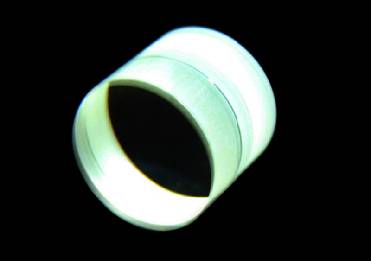Achromatic cemented triple lens actually refers to a type of photoelectric glass that is a combination of liquid crystal dimming film and glass sandwich glue, which has the effect of "transparent on power and transparent on off power."
When purchasing achromatic cemented double lens, one of the most important parameters of customers is the light transmittance. The higher the light transmittance, the better the product. The light transmittance of cemented lenses is mainly affected by the following three aspects: original glass, laminated film and dimming film.
First of all, glass. Glass is mainly divided into ordinary white glass and ultra white glass. Ordinary white glass contains various metal oxides such as iron oxide and manganese oxide. It looks greenish in color, and its light transmittance is generally 82% to 84%; the metal oxide contained in ultra-white glass is extremely low and looks crystal clear Clear, high-end and elegant, its light transmittance is generally 89% ~ 91%, but the light transmittance of ultra-white glass manufactured by the most advanced equipment is only 93%.
Then let's talk about film. There are two types of film for gluing mirror clips: EVA and PVB. The better transparencies can have a light transmittance of over 90%, while films of different qualities and colors have a large difference in light transmittance, which will not be repeated here.

Achromatic Cemented Triple Lens
The light transmittance of the dimming film is the most important factor affecting the light transmittance of the cemented mirror. The dimming film is divided into domestic film and imported film. The light transmittance of domestic film is generally between 73% and 83%. The light transmittance of imported films is generally higher than that of domestic films, and the light transmittance can reach 85% or higher, but the price also rises.
In cemented lenses, it is more important to pay attention to the application and design of hollow cemented lenses (because in the curtain wall, the glass occupies a much larger area than the aluminum alloy frame). If 10 + 12A + 10 insulating glass is used, the heat transfer coefficient K is about 3.0W / (m2K), and the heat transfer coefficient is nearly 1/2 lower than that of single-layer glass, which can greatly reduce energy consumption. In the case of relatively high performance requirements, insulating glass should be used. If the insulating glass is filled with inert gas, its K value can be reduced to 1.3W / (m2K).
Under the condition that the cross-section of the aluminum alloy profile is unchanged, the insulating glass of different thickness is assembled by changing the size of the heat insulation strip and the rubber strip, so as to achieve different insulation design requirements for different regions, different types of buildings, different Ask the owner to choose. The use of thermal insulation curtain wall can play a very good energy saving and noise reduction effect.
Compared with ordinary single-layer glass, it saves about 25% ~ 50% of energy consumption and reduces noise by about 30db ~ 40db. Node design of dynamic curtain wall Dynamic curtain wall is a new type of energy-saving curtain wall and a new development of curtain wall technology. According to its structure, it can be divided into two types: "closed internal circulation system" and natural ventilation "open external circulation system". The former requires forced ventilation through the motor, so the overall energy saving level is not high; the latter through natural ventilation, so the energy saving effect is more obvious.